As the world advance, so do activities and human orientation to nature adjusts. Before now, no one ever thought of the possibility that one day, some individuals would wish to change their gender or any significant expressed phenotypic features that qualifies them to be classified under a specific gender. The modification is however, merely physical and has absolutely nothing to do with alterations in the genome of the individual. Who knows, maybe in two decades to come, we would have transgenic humans (this time, individuals with genetically modified DNA). I however don't wish a day like that should ever come.
I think this topic will be more comprehensible if we clearly define what transgenesis is and the main purpose for it. Transgenesis is the intentional modification of an organism's gene with the sole aim of either improving the existing gene against infection or disease or removing genes that are associated with disease aetiology. You either remove a gene or add to an existing gene. In all, the resultant product or the organism that results from the alteration in the genetic content of an organism is referred to as transgenic organism, and this can either be done in plants or animals.

Diagram of a piece of DNA being removed by tweezers. Modified from two other commons files. Used to illustrate genetic engineering for series template
As of writing this article, strictly speaking, there is no transgenic human in existence. Do not confuse transgender or transhumanism with transgenesis. In fact, transgenesis is more commonly used when we are talking about the alteration in the genetic content of an animal or a plants. When you talk about Transgender, it refers to an individual whose gender identity does not match the sex they were assigned at birth. For example, you were born a male from birth, but you suddenly someday, for reasons best known to you, decide to be addressed and seen as a female.
Transhumanism like I eelier, has little or no significant effect on the individual's DNA. You could dress as a woman or as a man, wear ear ring, plate your hair, put on lipstick, insert artificial breast, fix artificial buttocks and more. The fact still remains that, a man born as a man from birth can never menstruate as a woman, neither can a woman born as a woman from birth have penis and ejaculate as a man or even have XY chromosome as a normal man. Some of these attributes are strongly tied to our genes.
Now that we have clearly explained these two things, my focus is on transgenesis in plants and animals, I intend to explore how these concept affects us as humans. It is easier to modify the genes of plants and lower animals than it is when we ae are dealing with higher animals and also humans.
How transgenesis in plants came about
Transgenic plants simply mean any plant that whose DNA has been altered by any means. It could either intentional or by accident. In most cases, it is usually intentional and could be for research purpose or to find a cure to a disease plaguing human, animals or the plant itself. Whatever be the reason behind the gene modification, as long as the gene is tampered with and this results to the development of animal or plants with genetic expression that differs from its prior gene content, it is called a transgenesis organism. Now in our case, since we are talking about plants, they called Transgenic plants or genetically modified plants.
Alterations in DNA can come in different form, either you introduce an entirely new or foreign DNA into the plant or you modify the plant's existing DNA. The big question here is this, why alter the gene of the plant. Well, the answer is simple, it was discovered that some plants are most prone to attack by pests that damage not only the plants but also reduce the economic value of farm produce.
Damages caused by pests were a very big challenge to farmers then, not until it was discovered that some genes that made some plants resistant to a particular pest or disease vector could actually be extracted and incorporated another plant, in order to make them acquire similar resistant trait. Not only did the process made the plant resistant, some new traits acquired enriched the new plants with improved nutritional content.
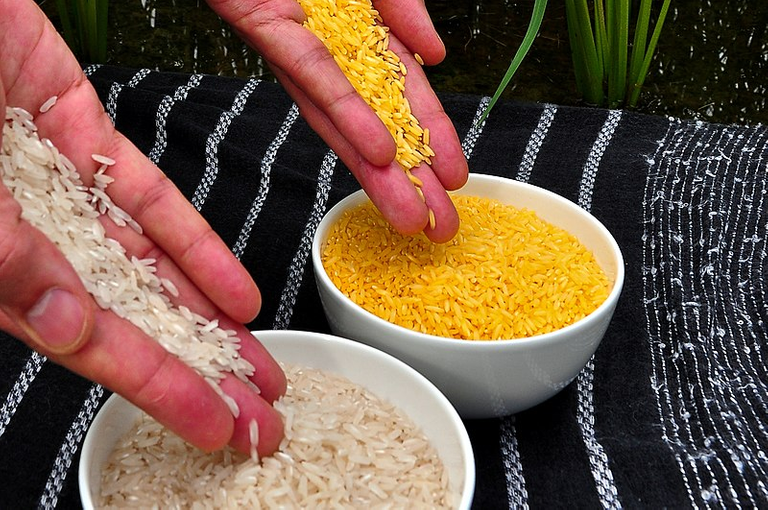
Golden Rice grain compared to white rice grain in screen house of Golden Rice plants
A typical case of this was the production of Golden rice, a genetically modified rice variety that was developed by Ingo Potrykus and Peter Beyer in the 1990s. They developed a type of rice that was highly rich in beta-carotene, which is a precursor for the synthesis of vitamin A. The beta-carotene content was what gave the rice its golden yellow colour appearance. As you know, Vitamin A plays a critical role in proper vision in humans and animals in general. They were able to do this by extracting the DNA or genes from the maize - Daffodil and the soil bacterium - Erwinia uredovora and the introducing these genes into a rice genome.
The reason for this experiment was that, white rice had no vitamin A content and the lack of this vitamin was a major problem then, in most developing countries that lacked vitamin A and also those countries that eat rice as a staple food. Generally, you do not find Vitamin in any plant source because Vitamin-A is strictly gotten from animal sources like milk etc.
Peter Bramley discovered that a single phytoene desaturase gene (bacterial CrtI) can be used to produce lycopene from phytoene in GM tomato, rather than having to introduce multiple carotene desaturases that are normally used by higher plants. Lycopene is then cyclized to beta-carotene by the endogenous cyclase in golden rice
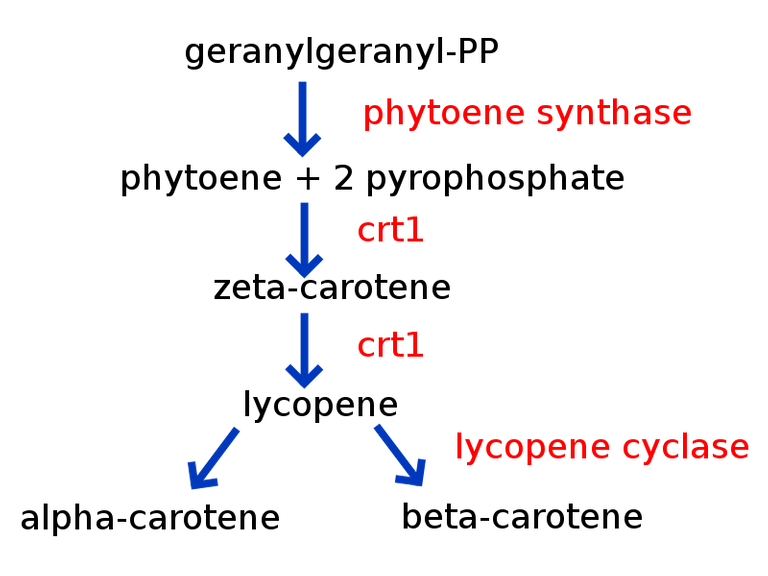
Simplified carotenoid biosynthesis, showing the role of the genes added to golden rice
No doubt, white rice has abundant carbohydrates content which can be a great source of energy for humans. However, it lacked Vitamin A, a very important nutrient needed by the body. So inserting and equipping the white rice with genes that could make them produce that one very important thing required - Beta-Carotene, for the vitamin-A, was just the right step in the right direction. Vitamin A deficiency can lead to blindness, weakened immune systems, and even death, hence the essence finding a way to address the challenge before it causes more havoc.
Even though this rice as seen, offers great benefits, it still was not widely accepted because of safety concerns. Well, indeed, it is something to be worried about. Deviating from the natural could have associated consequences. Well till date, there has been no evidence to show that golden rice has any side effect or health consequences whatsoever, hence. Does this imply that genetically modified plants do not have any negative impact whatsoever? Well, quite difficult to conclude, at least not just yet.
One of the reason why WHO adopted it to be safe, was due to the fact that after the extensive research done on it, it was discovered to be safe for consumption. In fact, it was clearly shown to be effective in addressing vitamin A deficiency in clinical trials that were conducted. Alright, enough with the golden rice, let's explore the general mechanism of creating transgenic organisms, however, we will give attention to plants for today.
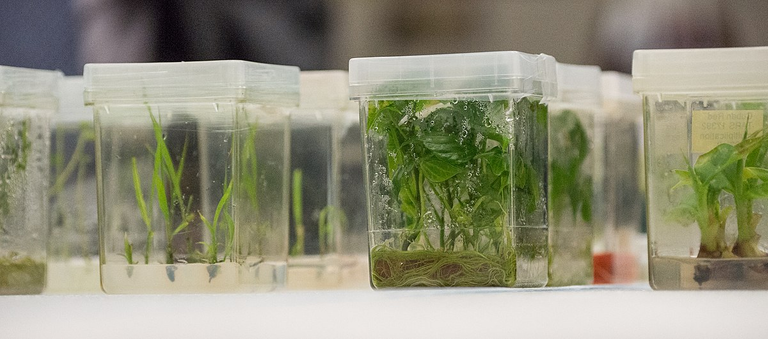
Plant tissue cultures being grown at a USDA seed bank, the National Center for Genetic Resources Preservation
The road to transgenic plant creation
Generally, it is easier to carryout genetic manipulation on animal cells and tissue but in plants, it is a different ball game, and can be very complicated. One of the reasons is that, plants have very rigid cell wall that protects its cytoplasmic contents. You can easily penetrate that of animal cells but definitely not so easy in plants. Just like how animals can be cultured in cell culture containers, plant cells can also be cultured in likewise, and it is referred to as Callus culture
A callus is a mass of cells that form at the site of a wound on a plant. By extension, they are mostly undifferentiated cells (cells that are yet to have a specific and defined function). Callus formation is actually a natural of most plants in response to tissue injury. This helps protect them from further damage and at the same time allows it repair itself properly. Because these cells are undifferentiated, they can easily be induced or engineered in the laboratory.
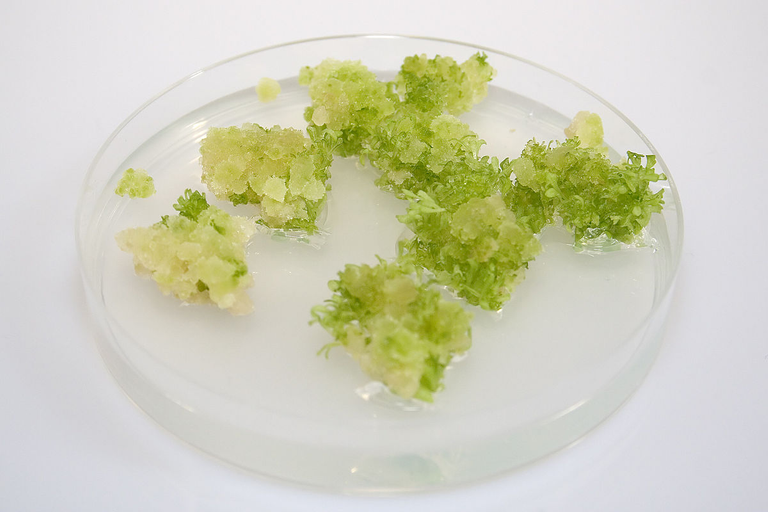
Callus culture of Nicotiana tabacum parenchyma cells in culture
To genetically modify a plant's gene, you will need to various method genetic engineering to be able to accomplish this task. Basically, there two major routes of genetically altering or delivering foreign DNA into another host gene of an organisms or plants. You can do it either through a process known as Vector-mediated gene transfer or through Direct gene transfer.
In Vector-mediated gene transfer, just as the name suggest, a vector (carrier molecules on which foreign genes to be incorporated into another host are attached) is used to transfer the the desired gene into the plant cell. This method falls under what is referred to as transduction. In transduction, there must be a gene carrier that will facilitate the delivery of the recombinant gene into the host cell.
On the other hand, in direct gene transfer, you do not need any carrier vector, rather, the gene is transferred into the cell of the organism directly. However, before this can be possible, the cell must be in a competent state. A cell is said to be competent, if it is able to actually receive foreign DNA. This is most common in bacteria cell where you can have horizontal gene transfer (one of the simple and natural way through which bacteria cells exchange genetic materials).
Because of how rigid and complex the cells of plants are, the above methods are not used commonly used, rather the most popular used method of gene transfer in plants is the use of a bacteria called Agrobacterium tumefaciens. This bacterium has an infectious plasmid called Tumour inducing (Ti) plasmid, which is its infectious molecule. When this bacterium infects plants, it causes what is known as the gall disease in plants.
When they infect plants, they behave like virus by transferring their T-DNA into the genome of the plant. Once this happens, they automatically redirect the plants cellular mechanism by converting their cells into tumour like ones and them at the same time, making them produce nutrients that are required for the bacteria to survive.
Another interesting thing about this bacterium is that, its plasmid i.e. the Ti plasmid encodes for two major enzymes in the plant - Cytokinin and auxin. Increased production of these enzymes results to excessive growth of the plant's cells. In this case, the gall disease, a type of tumour in the cells of the plant. It is for this reason that; their plasmid is referred to as tumour inducing plasmids (because they cause plant cells to proliferate or grow with no control).

Schematic representation of the general organization of a Ti plasmas housing the T-DNA
So the pathogenicity of Agrobacterium tumefaciens solely lies on the infectious state of its Ti plasmid and their ability to take over their host plant's cellular machinery. They first attach to the injury site of any plant and multiply their before then attaching to the cell wall of the plant before going deeper. Needless to here that, plants could be endangered when they cut open especially during pruning.
It is this unique interesting mechanism of how this bacterium infects plant, is what is been taken advantage of in biotechnology. All that is required is to extract the plasmid of this bacteria, remove the Ti particle using restriction enzymes, and then replace it with our gene of interest and then deliver this plasmid into our plant of interest.
As a rule of thumb, the very first step in producing transgenic plants is the identification of a specific gene or trait that is of interest to us. Since we are trying to either prevent disease or make the existing gene better, this very first step is crucial before proceeding with any other thing. The whole essence is always to transfer genes that could confer resistance to pests or diseases, genes that increase the plant's tolerance to environmental stresses like drought or cold temperatures, or even genes that improve the plant's nutritional content, just as we have seen in the case pf golden rice.
Once the above is done, we can then transfer this gene into the plant genome using the agrobacterium recombinant plasmid i.e. the plasmid containing our gene of interest. This method is called Agrobacterium-mediated transformation, which we have already explained above. This is the common method in plants unlike in animal cells where we use viral vectors. Also, another method this very much possible, is the use of what is known as biolistic transformation.

Gene gun
Under this method, we use a gene gun. Here, our recombinant DNA of interest is bound to a gold or tungsten particles, this is then shot into the plant's cell or tissue under conditions of high pressure using the gene gun. Once inside the cell of the plant, the DNA can then integrate into the genome of the host plant. It is as simple as that, however, agrobacterium is much more favoured than this method since it is much easier and less cumbersome. Though it is used in cases where it might seem very difficult to use the bacteria.
Once we have successfully performed the above (depending on any method we use), we can then culture these cells. Just like we earlier discussed, these cells that are grown and nurtured are called callus culture. It is not necessary that the plant must be genetically modified before it is cultured. Callus culture is just a general term that involves taking a small piece of plant tissue (such as a stem or leaf) and placing it on a nutrient-rich medium to stimulate the growth of a callus (the undifferentiated cells). Once the callus has formed, it then it much easier to induced to differentiate into new plants.
Just as cell culture plays a very important role in studying diseases and production of products in regenerative medicine, so also is the Callus culture useful for producing large numbers of genetically identical plants from a single parent plant, a process known as cloning.
So far, this callus culture, has helped us produce plants that are more resistant to diseases. In all, they have so far helped us curb the menace of pest. At least, instead of using all this organopesticide that are very toxic and dangerous, by simply modifying the gene of any plant that is probably at the verge of extinction, we could be saving ourselves a whole lot.
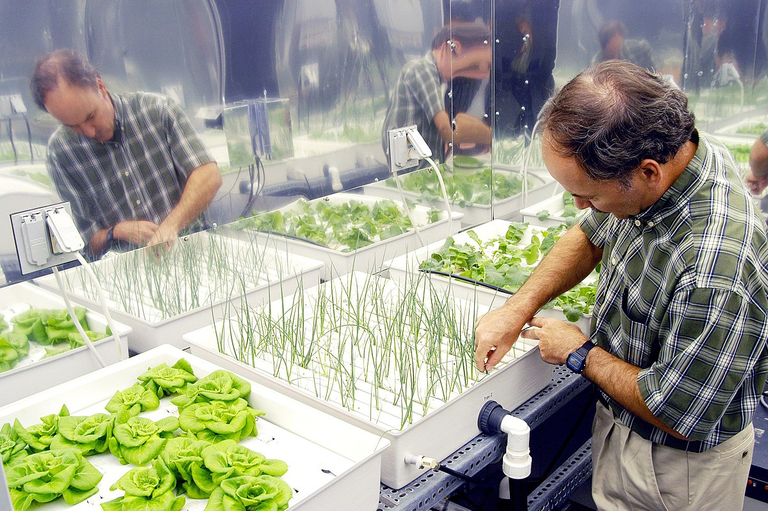
In a plant growth chamber in the KSC Space Life Sciences Lab, plant physiologist Ray Wheeler checks onions being grown using hydroponic techniques. The other plants are Bibb lettuce (left) and radishes (right). Wheeler and other colleagues are researching plant growth under different types of light, different CO2 concentrations and temperatures. The Lab is exploring various aspects of a bioregenerative life support system. Such research and technology development will be crucial to long-term habitation of space by humans
Are they all safe in this regard?
I asked a professor this same question not long ago, and so far, there has been no documented evidences to claim that transgenic plants are unhealthy as long they have been certified safe and secondly, reason being that, the process is highly and strictly regulated. Imagine everyone, farmers for example freely being able to modify the genes of plants without due safety and risk assessment testing.
We could end up having healthy plants that are genetically modified with the sole intention of producing high yield or developing resistance, but ends up producing highly toxic chemicals. The possibility is there, hence the reason for the strict regulation of this process of transgenesis.
From what I understand so far, products of genetic modifications from plant origin, pass through a very stringent risk assessment process before they are released into the market for sale and this involves evaluating its safety for humans, animals, and the environment in general. If it passes all these test, then it can be considered safe.
Alright, this is where I wrap it up. They may be safe for now; I cannot vouch for tomorrow. Later I will introduce you fully to transgenesis in animals and how this is done.
References
Advances and Perspectives of Transgenic Technology and Biotechnological Application in Forest Trees
Golden Rice: instructions for use
Allow Golden Rice to save lives
Golden Rice is an effective source of vitamin A
Recombinant DNA Technology and Transgenic Animals
Transgenic organisms
Plant responses to Agrobacterium tumefaciens and crown gall development

Congratulations!
✅ Good job. Your post has been appreciated and has received support from CHESS BROTHERS ♔ 💪
♟ We invite you to use our hashtag #chessbrothers and learn more about us.
♟♟ You can also reach us on our Discord server and promote your posts there.
♟♟♟ Consider joining our curation trail so we work as a team and you get rewards automatically.
♞♟ Check out our @chessbrotherspro account to learn about the curation process carried out daily by our team.
🥇 If you want to earn profits with your HP delegation and support our project, we invite you to join the Master Investor plan. Here you can learn how to do it.
Kindly
The CHESS BROTHERS team
❤️
This is an entirely complex procedure, I have read about something similar in animals, I really don't know what it is called, but in this case, completely different breeds of animals are crossed to produce an entirely different animal breed from what we know.
Yeah! Science always evolves, there is more to what we don't know yet.
Insightful enough.... I've learnt a lot of this post.... Keep posting stuffs like this,it will go a long way to enhance our knowledge on agronomy,science and agriculture... Thanks for the piece
Thanks for the read, happy you grabbed one or two.
Your content has been voted as a part of Encouragement program. Keep up the good work!
Use Ecency daily to boost your growth on platform!
Support Ecency
Vote for new Proposal
Delegate HP and earn more
❤️
Thanks for your contribution to the STEMsocial community. Feel free to join us on discord to get to know the rest of us!
Please consider delegating to the @stemsocial account (85% of the curation rewards are returned).
Thanks for including @stemsocial as a beneficiary, which gives you stronger support.
Congratulations @cyprianj! You have completed the following achievement on the Hive blockchain And have been rewarded with New badge(s)
Your next target is to reach 155000 upvotes.
You can view your badges on your board and compare yourself to others in the Ranking
If you no longer want to receive notifications, reply to this comment with the word
STOPCheck out our last posts:
Support the HiveBuzz project. Vote for our proposal!